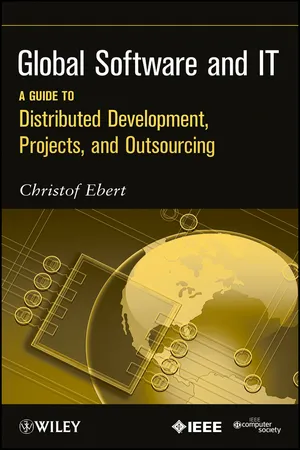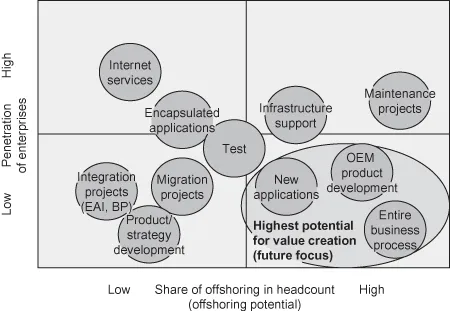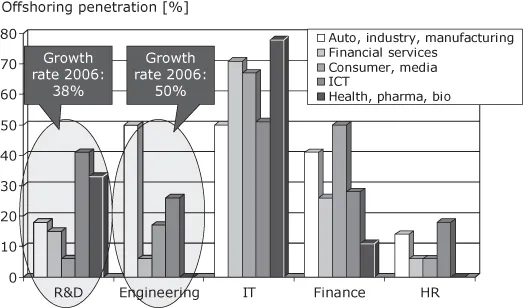
eBook - ePub
Global Software and IT
A Guide to Distributed Development, Projects, and Outsourcing
- English
- ePUB (mobile friendly)
- Available on iOS & Android
eBook - ePub
About this book
Based on the author's first-hand experience and expertise, this book offers a proven framework for global software engineering. Readers will learn best practices for managing a variety of software projects, coordinating the activities of several locations across the globe while accounting for cultural differences. Most importantly, readers will learn how to engineer a first-rate software product as efficiently as possible by fully leveraging global personnel and resources.
Global Software and IT takes a unique approach that works for projects of any size, examining such critical topics as:
- Executing a seamless project across multiple locations
- Mitigating the risks of off-shoring
- Developing and implementing processes for global development
- Establishing practical outsourcing guidelines
- Fostering effective collaboration and communication across continents and culture
This book provides a balanced framework for planning global development, covering topics such as managing people in distributed sites and managing a project across locations. It delivers a comprehensive business model that is beneficial to anyone looking for the most cost-effective, efficient way to engineer good software products.
Frequently asked questions
Yes, you can cancel anytime from the Subscription tab in your account settings on the Perlego website. Your subscription will stay active until the end of your current billing period. Learn how to cancel your subscription.
At the moment all of our mobile-responsive ePub books are available to download via the app. Most of our PDFs are also available to download and we're working on making the final remaining ones downloadable now. Learn more here.
Perlego offers two plans: Essential and Complete
- Essential is ideal for learners and professionals who enjoy exploring a wide range of subjects. Access the Essential Library with 800,000+ trusted titles and best-sellers across business, personal growth, and the humanities. Includes unlimited reading time and Standard Read Aloud voice.
- Complete: Perfect for advanced learners and researchers needing full, unrestricted access. Unlock 1.4M+ books across hundreds of subjects, including academic and specialized titles. The Complete Plan also includes advanced features like Premium Read Aloud and Research Assistant.
We are an online textbook subscription service, where you can get access to an entire online library for less than the price of a single book per month. With over 1 million books across 1000+ topics, we’ve got you covered! Learn more here.
Look out for the read-aloud symbol on your next book to see if you can listen to it. The read-aloud tool reads text aloud for you, highlighting the text as it is being read. You can pause it, speed it up and slow it down. Learn more here.
Yes! You can use the Perlego app on both iOS or Android devices to read anytime, anywhere — even offline. Perfect for commutes or when you’re on the go.
Please note we cannot support devices running on iOS 13 and Android 7 or earlier. Learn more about using the app.
Please note we cannot support devices running on iOS 13 and Android 7 or earlier. Learn more about using the app.
Yes, you can access Global Software and IT by Christof Ebert in PDF and/or ePUB format, as well as other popular books in Business & Operations. We have over one million books available in our catalogue for you to explore.
Information
Part I: Strategy
Chapter 1
Different Business Models
Summary: Globalized software development and various formats of information technology outsourcing (ITO) are as natural for the software and IT business as project management or requirement engineering. Going global with software and IT is a great way to distribute work effectively as well as appropriately assign tasks to employees who are most qualified for the task at hand. To attain the greatest success in the fields of software and IT we must take advantage of opportunities for continuous collaboration around the globe. This chapter looks at different business models in software and IT.
The annual volume of global IT outsourcing and software development in 2010 was approximately $100 billion. Considering the field’s growth rate of 5 to 10 percent per year, the industry is clearly rife with portential [BCG09, McKinsey08]. When one examines the facts about the software business, it becomes readily evident that it has become a truly global venture. Examples are manifold:
- Offshoring is growing at double-digit rates across Europe and the United States throughout many different industries and all major business functions.
- Offshoring is no longer just about cost reduction, low-end manufacturing, IT, and back office work; it has become a major driver for entire business processes.
- 50% annual growth in the offshoring of core innovation activities (i.e., R&D, product design, engineering).
As early as 1962, EDS began offering IT on spare capacity, also known as time-shared computing as an external service (today this is called application service provisioning). In 1976 EDS started deploying global IT services, such as financial accounting. Entrepreneurs in India realized early on that this form of business could help the country leapfrog into current technologies, therefore becoming a major business partner to the Western world. Indian institutes of technology were formed in the 1960s. They featured strong computer science curricula which laid the foundtions for India’s current success in the IT domain. The first e-mail sent from China to a foreign country was on September 20, 1987 to the University of Karlsruhe. The text was short, yet powerful: “Across the Great Wall we can reach every corner in the world.” It was the vision of an increasingly connected world in which all citizens and enterprises would have the ability to do business with one another. The world was getting smaller. The notion of “across the wall” is about bridging gaps. It demonstrates that being connected does not necessarily mean sharing the same values with one another, nor does it make countries and continents borderless and integrated.
Today, practically all new business plans contain offshoring as a key element for containing cost and creating flexibility in order to cope with changing demands on skills and numbers of engineers. Different business models are applied in the global context.
First, there is a distinction made between outsourcing and offshoring:
- Offshoring—is a business activity beyond sales and marketing which takes place outside the home country of an enterprise. Enterprises typically either have local branches in low-cost countries or they ask specialized companies abroad to perform a service for them.—Offshoring performed within the company is called captive offshoring.
- Outsourcing—is a business’s lasting and result-oriented relationship with a supplier who executes business activities for an enterprise which were traditionally executed inside the enterprise. Outsourcing is site-independent. The supplier can reside in direct neighborhood of the enterprise or offshore.
Offshoring and outsourcing are two dimensions in the scope of globalized software development and IT. They do not depend on each other and can be implemented individually.
For sourcing, a distinction is made based on the type of service being sourced from an external supplier:
- Business Process Outsourcing (BPO)—where a business process (or business function) is contracted to a third-party service provider.
- Information Technology Outsourcing (ITO)—where software and It related services are outsourced to a third-party service provider. ITO is a form of Business Process Outsourcing (BPO) for software and information technology activities.
- Application service provisioning (ASP)—where computer-based services are sourced from a third-party service provider. ASP is a form of Information Technology Outsourcing (ITO) for operationally provisioning software and IT functionality.
- Software sourcing—where software components are sourced from an external supplier. Sourcing is a business process that summarizes all procurement practices. It includes finding, evaluating, contractually engaging, and managing suppliers of goods and services.
- Open source—where, considering restrictions such as IPR, software is sourced from a supplier (often unknown) and a community of developers in different parts of the world. Global software and IT do not depend on having legal entities as suppliers. The open source movement has shown that big global software projects can also be conducted by enthusiastic individuals.
The time and relationship perspective of the outsourcing demands a third distinction:
- Tactical Outsourcing—is a form of outsourcing with short-term (“just in time”) focus. Suppliers are selected on a case-by-case basis for activities within projects. Those suppliers who are best suitable for the concrete task at hand are selected . Tactical outsourcing, which is similar to subcontract management, is used to improve operational efficiency.
- Strategic outsourcing— is a form of outsourcing with long-term and sustainable focus. A business process is moved to an external supplier in order to focus resources on the core business. Within engineering projects this can be a process (e.g., maintenance, test) or a system (e.g., legacy product). Strategic outsourcing changes the entire value chain.
Outsourcing and offshoring allow more flexibility in managing operational expenses because resources are allocated to places and regions that are most suited to flexible needs and ever-changing business models. Figure 1.1 summarizes the reasons for outsourcing and offshoring [Ebert07a, BCG09, IAOP09, IDC07, Hussey08, Rivard08]1.
Figure 1.1 Reasons for outsourcing and offshoring.

Figure 1.2 shows the penetration of enterprises with different types of global development and IT activities [IAOP09, Aspray06]. The horizontal axis provides the share of offshoring (as a proxy for the degree of global software engineering and IT in an enterprise for an activity) and the vertical axis provides a view on the penetration of enterprises for a specific activity. For instance, maintenance projects already penetrate more than half of all software activities worldwide (position on vertical axis) and it is typically done in an offshore environment rather than a single place in a highly paid country (right position on horizontal axis). Some activities, such as new applications and OEM product development, are clearly not yet where they could be.
Figure 1.2 Impacts of IT and software offshoring.

The share of offshoring or globalization depends on the underlying IT needs and on what software is being developed. While for mere IT applications or internet services global development is fairly easy, embedded software still presents major challenges to distributed development. A 2010 study by embedded.com found that only 30% of all embedded software is developed in a global or distributed context, while the vast majority is collocated. Similarly, the amount of quality deficiencies and call-backs across industries has increased in parallel to growing global development and sourcing.

The journey has begun, but it is far from being clear what the end result will be. Some countries will come to saturation because global development essentially means that all countries and sites have their fair chance to become players and to compete based on skills, labor cost, innovativeness, and quality. Software engineering is based upon a friction-free economy in which any labor is moved to the site (or engineering team) that is best suitable amongst a set of constraints. No customer is in a position to judge whether a piece of software from one specific site is better or worse when compared to the same software being produced somewhere else in the world. In essence, the old economy labels of “made in country x” has become a type of thinking that does not relate to software industries. What counts are business impacts and performance such as resource availability, productivity, innovativeness, quality of work performed, cost, flexibility, skills, and the like.
BUSINESS PROCESS OUTSOURCING
Business Process Outsourcing (BPO) is the form of outsourcing where a business process (or business function) is contracted to a third-party service provider. BPO involves outsourcing of operations and responsibilities of that process or function. For example, one could use BPO for business processes such as supply chain, maintenance, welcome desk, financial services, or human resources. Historically, Coca Cola was the first company to use BPO for outsourcing parts of their supply chain. In the software industry, EDS was the first supplier for outsourced services.
Today, business process outsourcing is a key element in most R&D and IT-driven industries. The reasons for this are manifold, and saturation has not yet been reached. In fact, outsourcing arrives at different speed in different industries. Figure 1.3 shows the offshore outsourcing penetration of different business processes across industries ranging from automotive and manufacturing, to finance, consumer, ICT, and health [Duke07].
Figure 1.3 The penetration of business process outsourcing (BPO).

IT functions have the highest degree of outsourcing capacity across the five sectors, however, the core of these sectors, namely R&D and engineering functions, are at the steepest growth rate. No longer are support functions and services outsourced as we were once used to. Today’s emphasis is on globally utilizing research and engineering to develop products. Global software engineering and IT are at the crossing point of both the IT sector and the engineering function which naturally builds the spearhead of this radical business change. IT outsourcing has reached 50% and more of all expenses for IT services occur across industries. But R&D and engineering is not yet saturated. They will continue to grow at rates way above 20% per year. This means that global software development as well as IT service outsourcing will further grow during this decade.
INFORMATION TECHNOLOGY OUTSOURCING
Information Technology Outsourcing (ITO) is the form of outsourcing in which software and IT related services are outsourced to a third-party service provider. ITO is a form of Business Process Outsourcing (BPO) for software and information technology activities. Historically, EDS was the first ITO supplier. Examples of ITO are outsourcing of software maintenance or IT provisioning services.
ITO is either driven by the need to reduce capital costs or by business process outsourcing. There is hardly any strategic component in ITO despite the fact that many companies claim otherwise. Essentially, companies that are in need of capital in the short term sell their IT assets and resources while immediately sourcing it back to maintain services. As shown in recent years by the cases of Xerox, J.P. Morgan, Swiss Bank, and Delta Airlines, when a company claims strategic reasoning in the sale of IT assets, in reality, the ITO has actually failed to deliver the expected long-term benefits. [Lacity09]. Realizing any strategic goals with ITO is difficult and demands a high degree of managerial attention.
GLOBAL SOFTWARE ENGINEERING
Global software engineering (GSE) is software development and maintenance in globally distributed sites. Different business models and work breakdown sc...
Table of contents
- Cover
- Title page
- Copyright page
- Foreword
- About the Author
- Introduction
- Part I: Strategy
- Part II: Development
- Part III: Management
- Part IV: People and Teams
- Part V: Advancing Your Own Business
- Appendices
- Glossary and Abbreviations
- Bibliography
- Index